(Refer to
 , GROUP 11A - On-Vehicle Service.)
, GROUP 11A - On-Vehicle Service.) 
 , GROUP 11A - On-Vehicle Service.)
, GROUP 11A - On-Vehicle Service.) | note | The way of disconnecting the alternator output wire and of connecting the ammeter is possibly not found the problem that the output current is dropping due to the insufficient connection between terminal "B" and the output wire. |
| note | When the alternator output is high and the value displayed on the ammeter does not decrease until 30 A, set the value to 40 A. Read the value displayed on the voltmeter at this time. When the value range is 40 A, the limit is maximum 0.4 V. |